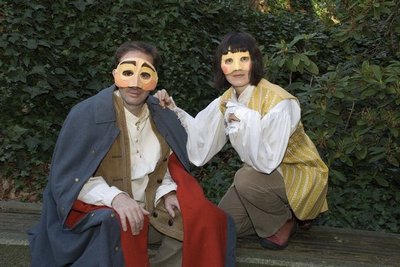March 6, 2008
Students polish language skills by performing plays in Spanish
Students in Donald Gilbert-Santamaria’s Spanish 449 Class are learning by playing this quarter. The class consists of rehearsing three short plays in Spanish that will be presented at 7:30 p.m. March 14 and 15 in the Ethnic Cultural Theatre.
The three plays have been selected to highlight the breadth of Spanish theatrical work in the so-called “Golden Age,” which stretched from 1492 to about 1650. Two of the plays — Miguel de Cervantes’s El retablo de las maravillas and the anonymously penned Entremes de los romances — are comedies known as entremeses, short one-act plays that were originally performed during the intermission of longer works. The third is a more serious work by Sor Juana Ines de la Cruz, a Mexican nun, and was intended to be performed as part of a religious festival.
The class is a follow-up to a fall quarter offering in which students studied 17th century Spanish theater, including these three plays. “For students involved in both classes, it’s an opportunity to study the plays first in an academic environment and then to go through the process of trying to produce them,” Gilbert-Santamaria said.
This isn’t the first time a class in play production has been offered in the Department of Spanish and Portuguese Studies. The class was previously a standalone offering taught by Anna Witte, a lecturer who has since moved out of state. Last year, there was one role that Witte was unable to cast, so she asked Gilbert-Santamaria if he would take it.
Watching the process from the inside was a revelation for Gilbert-Santamaria. “I’ve taught plays for years in academic settings, and with these early plays it’s very hard to get students to understand that they’re not just texts,” he said. “They’re group projects in a way. Meaning is created not just through the words but also the interpretive process which is production. So this allows students to experience it for themselves.”
Only a few students in the play production class were part of the fall theater survey course, so the quarter began with discussions of the plays, putting them into context. The first public theaters opened in Madrid in the late 16th century, Gilbert-Santamaria said, and the two entremeses would have been performed there as entertainment for a paying audience. Entremes de los romances is believed by some to have been the inspiration for Don Quixote, and deals with the connection between literary excess and madness.
Cervantes’ play — his best-known work for the theater — is an Emperor’s New Clothes kind of story in which some charlatans come to town and say they have a play to put on, but the only people who will be able to see it are the people who have not been converted to the “new” Christianity.
“The trick is that there’s nothing to this play they’re doing, but everyone pretends to see it because nobody wants to be accused of not having the right beliefs,” Gilbert-Santamaria said. “This is the time of the Inquisition, so understanding the historical context is crucial to understanding the play.”
Sor Juana Ines de la Cruz’s work is an allegorical representation of the first encounter between Spanish and indigenous cultures in the New World. It is a loa, an introductory play for a longer, religious play that is normally performed during the festival of Corpus Christi.
“It takes some digs at the Spanish colonial project in kind of an interesting way,” Gilbert-Santamaria said.
After the initial discussion of the plays, the students went about rehearsing them. Witte has returned to collaborate with Gilbert-Santamaria in directing them. She has also designed costumes — including elaborate masks — and is choreographing several short dances that will be part of the production.
In addition to learning their parts, the students have to write a diary in Spanish every week in which they think about their character and how their relationship to their character changes.
Ben Christiansen, a graduate student in the Information School who is taking the class, said he’s learned a lot. “Learning my character’s lines has forced me to look more closely at the plays and really think about what each word means,” he said. “This has helped me expand my Spanish vocabulary a bit, but more than anything, acting has given me a good opportunity to refine my pronunciation. Saying the same lines over and over makes you think about how you say them, and I don’t want my Gringo-ness to distract from the audience’s enjoyment of the plays.”
Gilbert-Santamaria says Christiansen’s experience is typical. “When students learn their lines well enough to talk and act at the same time, they’ve begun to internalize the language,” he said. “We had a student who did this last year who just struggled and struggled, but then she really hit the mark and I could see in her this effect of having been able to do this and how it changed her relationship to the language.”
In addition to the class and the play performances, Gilbert-Santamaria is offering a workshop for high school teachers in which he’ll talk about the cultural and historical context of the plays and model the process he used to teach the texts. Participating teachers will be invited to attend a performance.
The performances are open to the public, and Gilbert-Santamaria said there will be background information provided to help people who don’t speak Spanish. There will be a Q&A session with the performers after the Friday performance. Tickets to the plays will be available at the HUB Ticket Office. They are $10 ($8 for students).



